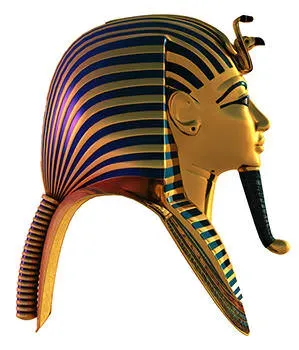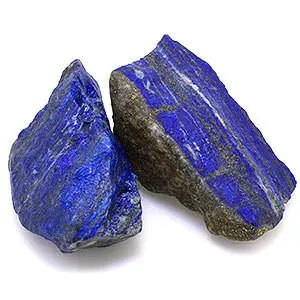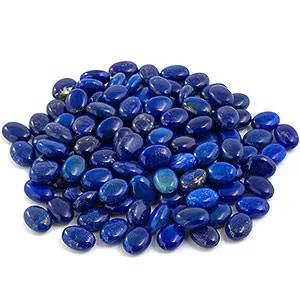
![]() Lapis lazuli has been used in jewelry, carvings and amulets for thousands of years. It is a stone prized for its intense blue color. The name Lapis Lazuli comes from the Arabic word lazward, from which the word azure comes, which means blue. Ancient Romans used to call it "sapphires," which was subsequently applied to the blue variety of corundum we know today as
Lapis lazuli has been used in jewelry, carvings and amulets for thousands of years. It is a stone prized for its intense blue color. The name Lapis Lazuli comes from the Arabic word lazward, from which the word azure comes, which means blue. Ancient Romans used to call it "sapphires," which was subsequently applied to the blue variety of corundum we know today as ![]() sapphire. Egyptians regarded lapis lazuli as a heavenly stone and often used it on the statues of their gods and in burial masks, as protection for the next life. The stone has been used in many famous pieces throughout history, including the mask of Tutankhanem, or King Tut. Egyptians used lapis lazuli for cylindrical seals. Sumerians, the supreme lapis lovers of antiquity, were willing to spend years traveling from one end of Asia to the other, on mining expeditions for the gem. In fact, the stone was mentioned in their 2650 BC epic of Gilgamesh. During the middle ages, ruling class art patrons demanded that painters use blue paint that was made from blue lapis. Men of less means had to tolerate cheaper blue pigments made from indigo or copper.
sapphire. Egyptians regarded lapis lazuli as a heavenly stone and often used it on the statues of their gods and in burial masks, as protection for the next life. The stone has been used in many famous pieces throughout history, including the mask of Tutankhanem, or King Tut. Egyptians used lapis lazuli for cylindrical seals. Sumerians, the supreme lapis lovers of antiquity, were willing to spend years traveling from one end of Asia to the other, on mining expeditions for the gem. In fact, the stone was mentioned in their 2650 BC epic of Gilgamesh. During the middle ages, ruling class art patrons demanded that painters use blue paint that was made from blue lapis. Men of less means had to tolerate cheaper blue pigments made from indigo or copper.
 You can see beautiful blue lapis lazuli paint in many Renaissance paintings today. Lapis is, to this day, one of the most valuable semi opaque ornamental materials, worth about the same as good quality
You can see beautiful blue lapis lazuli paint in many Renaissance paintings today. Lapis is, to this day, one of the most valuable semi opaque ornamental materials, worth about the same as good quality ![]() turquoise and the better jades, excluding imperial
turquoise and the better jades, excluding imperial ![]() jade. Lapis has become a men's ring mainstay. It is one of world's most popular men's gems, second only to black
jade. Lapis has become a men's ring mainstay. It is one of world's most popular men's gems, second only to black ![]() onyx.
onyx.
 Lapis Lazuli is a blue rock made of several different minerals including lazurite, sodalite, hauyne, calcite (which shows as white flecks), and pyrite (which adds a golden yellow sparkle). The composition and color of each stone varies, but it's the general intense dark blue color that is considered its best quality.
Lapis Lazuli is a blue rock made of several different minerals including lazurite, sodalite, hauyne, calcite (which shows as white flecks), and pyrite (which adds a golden yellow sparkle). The composition and color of each stone varies, but it's the general intense dark blue color that is considered its best quality. ![]() Lapis lazuli has a uniform, massive appearance with distinct crystals, and can be semi opaque or opaque. Its color is of a strong, lively blue, sometimes with hint of violet. It often contains grayish or off-white patches or veins. The presence of these white patches reduces the value of the stone.
Lapis lazuli has a uniform, massive appearance with distinct crystals, and can be semi opaque or opaque. Its color is of a strong, lively blue, sometimes with hint of violet. It often contains grayish or off-white patches or veins. The presence of these white patches reduces the value of the stone.
 The most highly prized lapis lazuli stones are uniformly colored and without a violet tinge.
The most highly prized lapis lazuli stones are uniformly colored and without a violet tinge. ![]() Lapis lazuli stones vary in hardness, ranging from a 5 to 5.5 on the hardness scale. The stone has vitreous luster. Lapis Lazuli has been thought to protect against evil for thousands of years. The Greeks and Romans used it as a reward for bravery. Both the ancient Egyptians and Babylonians believed it could cure melancholy. In the 17th century, it was used to prevent miscarriages, dementia and epilepsy. Today, it is used in Chinese medicine to treat phlegm, congestion and spasms. Lapis Lazuli is found as boulders within limestones. It has been mined in Afghanistan since remote antiquity. In fact, ancient Egyptians probably obtained their supplies from there. Argentina is also a source of high quality stones. A pale blue variety occurs in the former USSR and in Chile. The stone is also found in the US, Canada, Burma, and Pakistan.
Lapis lazuli stones vary in hardness, ranging from a 5 to 5.5 on the hardness scale. The stone has vitreous luster. Lapis Lazuli has been thought to protect against evil for thousands of years. The Greeks and Romans used it as a reward for bravery. Both the ancient Egyptians and Babylonians believed it could cure melancholy. In the 17th century, it was used to prevent miscarriages, dementia and epilepsy. Today, it is used in Chinese medicine to treat phlegm, congestion and spasms. Lapis Lazuli is found as boulders within limestones. It has been mined in Afghanistan since remote antiquity. In fact, ancient Egyptians probably obtained their supplies from there. Argentina is also a source of high quality stones. A pale blue variety occurs in the former USSR and in Chile. The stone is also found in the US, Canada, Burma, and Pakistan.